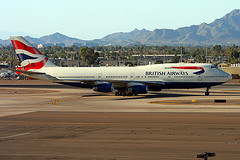Tarmac Regulations May Be Extended To Cover International Flights
Less than a year after the Dept. of Transportation introduced controversial regulations limiting the amount of time planes making domestic flights can sit on airport tarmacs, the agency is planning to expand those rules to cover overseas carriers that use American airports.
Currently, any domestic flight that waits on the tarmac for more than 180 minutes can be fined $27,500 for every passenger. In the eight months of 2010 during which the rules were in place, only 15 flights passed that 3-hour mark. That’s down from 584 for the same time period a year earlier.
From the Chicago Tribune:
Proponents of the rule point to the Dec. 26 storm that shuttered New York City’s airports and snarled air travel for much of the week between Christmas and New Year’s Day. Although airports were crippled by snow and ice, no U.S. carriers violated requirements that they provide passengers with food, water and a chance to exit an aircraft that has been on the ground for more than three hours.
But there were airline horror stories. Passengers on board United Kingdom-based British Airways and Hong Kong-based Cathay Pacific Airways Ltd. flights were trapped for hours after landing at John F. Kennedy International Airport while crews struggled to locate empty gates and immigration officials…
The proposed rules broaden the number of airports subject to the three-hour limit for tarmac delays and require foreign carriers to draw up contingency plans for getting stranded passengers off planes at U.S. airports.
However, a rep for the International Air Transport Association says that the act of getting passengers back to the gate is much more complicated for international flights:
There’s questions and confusion about gate availability, and questions and confusion about the availability of customs officials to process the international passengers… The New York City situation makes it more difficult for the Department of Transportation to write their final rule because it clearly shows that there are many different parties involved here.
Another criticism of the existing rule is that it hasn’t yet resulted in many more flights getting to their destination on time.
“The on-time arrival rate for the industry was 79.8 percent in 2010 versus 79.5 percent in 2009,” said an airline researcher at the Massachusetts Institute of Technology. “My take is that the delay is still occurring, just not as much on the tarmac as possibly at the gate.”
In addition to the expansion of the tarmac regulations, the DOT is set to issue a final version of the new rules regarding how much passengers would get compensated for being bumped from flights.
More airline passenger protections waiting in wings [Chicago Tribune]
Want more consumer news? Visit our parent organization, Consumer Reports, for the latest on scams, recalls, and other consumer issues.


